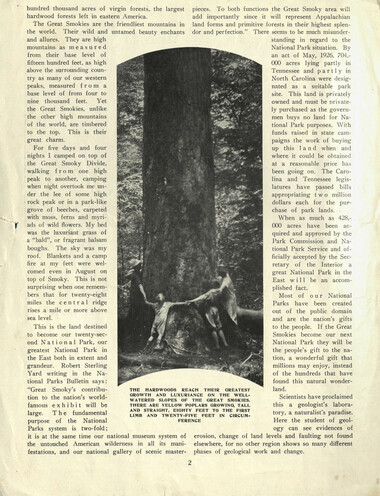Tramping in the Great Smokies
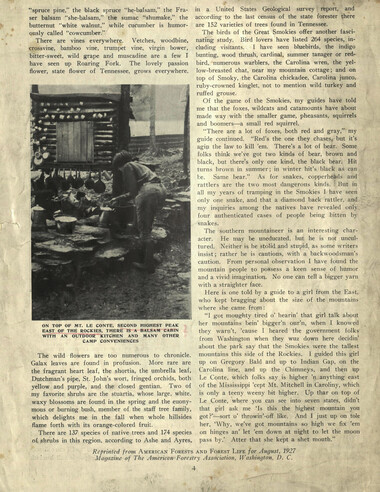
Tramping in the Great Smokies
GSMNP_13150_42_1109_04Item’s are ‘child’ level descriptions to ‘parent’ objects, (e.g. one page of a whole book).
-
- Format
- Type
- Source institution
-
Identifier
- GSMNP_13150_42_1109_04
-
"spruce pine," the black spruce "he-balsam," the Fra- in a United States Geological survey report, and ser balsam "she-balsam," the sumac "shumake," the according to the last census of the state forester there butternut "white walnut," while cucumber is humor- are 152 varieties of trees found in Tennessee, ously called "cowcumber." The birds of the Great Smokies offer another fasci- There are vines everywhere. Vetches, woodbine, nating study. Bird lovers have listed 264 species, in- crossvine, bamboo vine, trumpet vine, virgin bower, eluding visitants. I have seen bluebirds, the indigo bitter-sweet, wild grape and muscadine are a few I have seen up Roaring Fork. The lovely passion flower, state flower of Tennessee, grows everywhere. ON TOP OF MT. LE CONTE, SECOND HIGHEST PEAK EAST OF THE ROCKIES, THERE IS A BALSAM CABIN WITH AN OUTDOOR KITCHEN AND MANY OTHER CAMP CONVENIENCES The wild flowers are too numerous to chronicle. Galax leaves are found in profusion. More rare are the fragrant heart leaf, the shortia, the umbrella leaf, Dutchman's pipe, St. John's wort, fringed orchids, both yellow and purple, and the closed gentian. Two of my favorite shrubs are the stuartia, whose large, white, waxy blossoms are found in the spring and the euony- mous or burning bush, member of the staff tree family, which delights me in the fall when whole hillsides flame forth with its orange-colored fruit. There are 137 species of native trees and 174 species of shrubs in this region, according to Ashe and Ayres, bunting, wood thrush, cardinal, summer tanager or red- bird, numerous warblers, the Carolina wren, the yellow-breasted chat, near my mountain cottage; and on top of Smoky, the Carolina chickadee, Carolina junco, ruby-crowned kinglet, not to mention wild turkey and ruffed grouse. Of the game of the Smokies, my guides have told me that the foxes, wildcats and catamounts have about made way with the smaller game, pheasants, squirrels and boomers—a small red squirrel. "There are a lot of foxes-, both red and gray," my guide continued. "Red's the one they chases, but it's agin the law to kill 'em. There's a lot of bear. Some folks think we've got two kinds of bear, brown and black, but there's only one kind, the black bear. Hit turns brown in summer; in winter hit's black as can be. Same bear." As for snakes, copperheads and rattlers are the two most dangerous kinds. But in all my years of tramping in the Smokies I have seen only one snake, and that a diamond back rattler, and my inquiries among the natives have revealed only four authenticated cases of people being bitten by snakes. The southern mountaineer is an interesting character. He may be uneducated, but he is not uncultured. Neither is he stolid and stupid, as some writers insist; rather he is cautious, with a backwoodsman's caution. From personal observation I have found the mountain people to possess a keen sense of hunior and a vivid imagination. No one can tell a bigger yarn with a straighter face. I I ere is one told by a guide to a girl from the East, who kept bragging about the size of the mountains where she came from: "I got moughty tired o' hearin' that girl talk about her mountains bein' bigger'n our'n, when I knowed they warn't, 'cause 1 beared the government folks from Washington when they wuz clown here decidin' .about the park say that the Smokies were the tallest mountains this side of the Rockies. 1 guided this girl Up on Gregory Bald and up to Indian Gap, on the Carolina line, and up the Chimneys, and then up Me Conte, which folks say is higher 'n anything east of the Mississippi 'cept Mt. Mitchell in Caroliny, which is only a teeny weeny bit higher. Up thar on top of 1 ,e Conte, where you can see into seven states, didn't that girl ask me 'Is this the highest mountain you got?'—sort o' throwin'-off like. And I just up on tole her, 'Why, we've got mountains so high we fix 'em on hinges an' let 'em down at night to let the moon pass by.' Atter that she kept a shet mouth." Reprinted from American Forests And Forest LlFE for August, 1927 Magazine of The American Forestry Association, Washington, I). C.
Object’s are ‘parent’ level descriptions to ‘children’ items, (e.g. a book with pages).
-
This 4-page article, titled “Tramping the Great Smokies,” was reprinted from a 1927 issue of “American Forests and Forest Life, the magazine of The American Forestry Association. In it, the author writes about her first-hand experiences hiking and camping in the Smokies. A native of Tennessee, Laura Thornborough (1885-1973) was also the author of several books; her most well-known work is “The Great Smoky Mountains.” In this 1937 publication, Thornborough describes the mountains and surrounding communities and provides a first-hand history of the park’s formation. Besides the spelling “Thornborough,” she also spelled her name “Thornburgh.”
-
- Creator
- Format
- Type
-
Date
- Date original: 1927-08
- Date digitized: 2015-11-02
-
Extent
- Dimension: 11.5" x 9"
- Pages: 4 pages
- Subject - Topic
-
- Location
- Source institution
- Source Collection
-
Identifier
- GSMNP_13150_42_1109
-
Repository
- Great Smoky Mountains National Park
Related items
-
Western Carolinian Volume 54 Number 04

WCU - Western Carolina... Western Carolina... Western Carolina University...
Western Carolinian Volume 54 Number 04
-
Western Carolinian Volume 57 Number 10

WCU - Western Carolina... Western Carolina... Western Carolina University...
Western Carolinian Volume 57 Number 10
1991-10-24
-
Western Carolinian Volume 32 (36) Number 25

WCU - Western Carolina... Western Carolina... Western Carolina University...
Western Carolinian Volume 32 (36) Number 25
-
Western Carolinian Volume 60 Number 20
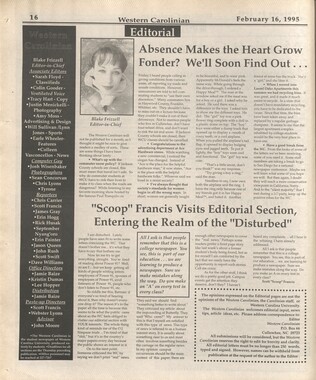
WCU - Western Carolina... Western Carolina... Western Carolina University...
Western Carolinian Volume 60 Number 20
-
Western Carolinian Volume 58 Number 22

WCU - Western Carolina... Western Carolina... Western Carolina University...
Western Carolinian Volume 58 Number 22
-
Western Carolinian Volume 42 Number 46

WCU - Western Carolina... Western Carolina... Western Carolina University...
Western Carolinian Volume 42 Number 46
-
Western Carolinian Volume 10 Number 10
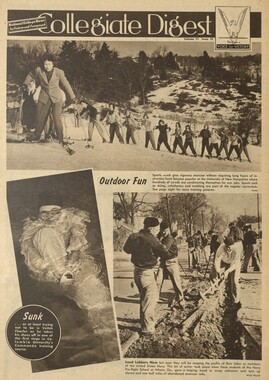
WCU - Western Carolina... Western Carolina... Western Carolina University...
Western Carolinian Volume 10 Number 10
-
Western Carolinian Volume 55 Number 15

WCU - Western Carolina... Western Carolina... Western Carolina University...
Western Carolinian Volume 55 Number 15
-
Great Smoky Mountains National Park / Land of the Everlasting Hills

WCU - Great Smoky Mountains - A... Great Smoky Mountains... Great Smoky Mountains - A Park...
Great Smoky Mountains National Park / Land of the...
-
Western Carolinian Volume 41 Number 38

WCU - Western Carolina... Western Carolina... Western Carolina University...
Western Carolinian Volume 41 Number 38
-
Western Carolinian Volume 44 Number 15

WCU - Western Carolina... Western Carolina... Western Carolina University...
Western Carolinian Volume 44 Number 15
1978-12-07
-
Western Carolinian Volume 54 Number 05

WCU - Western Carolina... Western Carolina... Western Carolina University...
Western Carolinian Volume 54 Number 05
-
Western Carolinian Volume 64 (65) Number 31
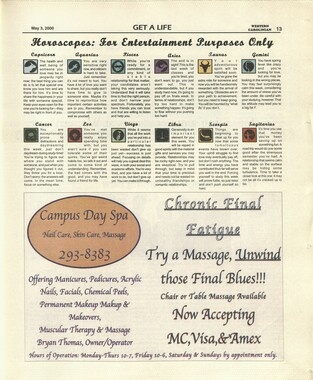
WCU - Western Carolina... Western Carolina... Western Carolina University...
Western Carolinian Volume 64 (65) Number 31
-
Irons in the Fire, p. 19

WCU - Craft Revival Craft Revival Craft Revival
Irons in the Fire, p. 19
1992
-
Western Carolinian Volume 70 Number 12
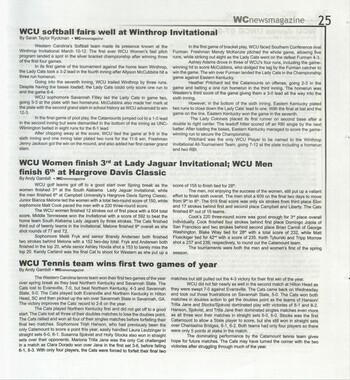
WCU - Western Carolina... Western Carolina... Western Carolina University...
Western Carolinian Volume 70 Number 12
-
Western Carolinian Volume 55 Number 13

WCU - Western Carolina... Western Carolina... Western Carolina University...
Western Carolinian Volume 55 Number 13
-
Western Carolinian Volume 64 (65) Number 10

WCU - Western Carolina... Western Carolina... Western Carolina University...
Western Carolinian Volume 64 (65) Number 10
-
Quarterly Magazine of the Southern Industrial Educational Association pages 22-23
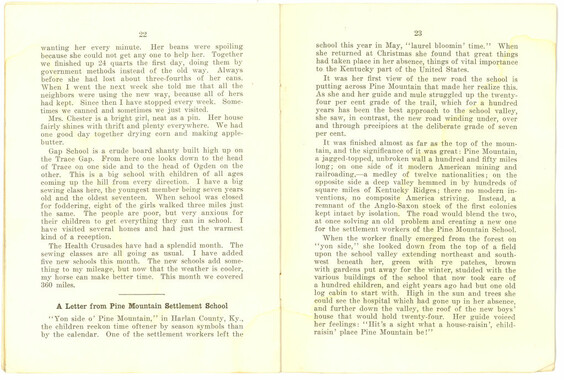
WCU - Craft Revival Craft Revival Craft Revival
Quarterly Magazine of the Southern Industrial...
1920
-
Western Carolinian Volume 59 Number 19 (18)

WCU - Western Carolina... Western Carolina... Western Carolina University...
Western Carolinian Volume 59 Number 19 (18)
-
Western Carolinian Volume 52 Number 10 (01)
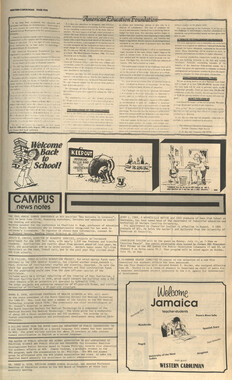
WCU - Western Carolina... Western Carolina... Western Carolina University...
Western Carolinian Volume 52 Number 10 (01)
-
Western Carolinian Volume 13 Number 03

WCU - Western Carolina... Western Carolina... Western Carolina University...
Western Carolinian Volume 13 Number 03
-
Western Carolinian Volume 40 Number 08

WCU - Western Carolina... Western Carolina... Western Carolina University...
Western Carolinian Volume 40 Number 08
1974-08-08;
-
Western Carolinian Volume 69 Number 12

WCU - Western Carolina... Western Carolina... Western Carolina University...
Western Carolinian Volume 69 Number 12
-
Western Carolinian Volume 43 Number 28

WCU - Western Carolina... Western Carolina... Western Carolina University...
Western Carolinian Volume 43 Number 28
-
Western Carolinian Volume 34 Number 41
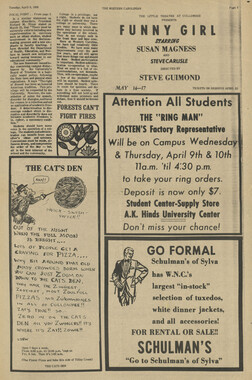
WCU - Western Carolina... Western Carolina... Western Carolina University...
Western Carolinian Volume 34 Number 41
-
Western Carolinian Volume 41 Number 52

WCU - Western Carolina... Western Carolina... Western Carolina University...
Western Carolinian Volume 41 Number 52
1976-05-13
-
Western Carolinian Volume 66 (67) Number 04

WCU - Western Carolina... Western Carolina... Western Carolina University...
Western Carolinian Volume 66 (67) Number 04
2001-10-31
-
Complete Report Submitted to Governor Clyde R. Hoey
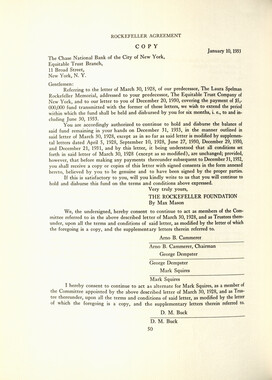
WCU - Great Smoky Mountains - A... Great Smoky Mountains... Great Smoky Mountains - A Park...
Complete Report Submitted to Governor Clyde R....
-
Memories of District C: Civilian Conservation Corps
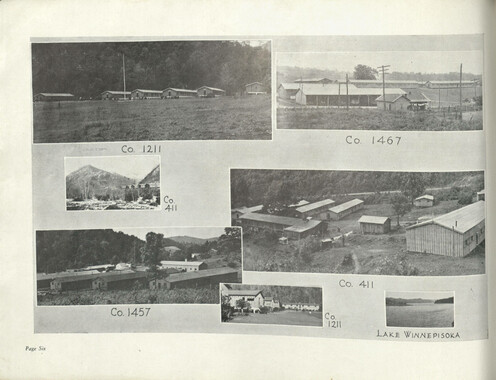
WCU - Great Smoky Mountains - A... Great Smoky Mountains... Great Smoky Mountains - A Park...
Memories of District C: Civilian Conservation...
-
Western Carolinian Volume 35 Number 24

WCU - Western Carolina... Western Carolina... Western Carolina University...
Western Carolinian Volume 35 Number 24
-
Western Carolinian Volume 55 Number 06

WCU - Western Carolina... Western Carolina... Western Carolina University...
Western Carolinian Volume 55 Number 06
1989-09-28
-
Western Carolinian Volume 67 Number 14

WCU - Western Carolina... Western Carolina... Western Carolina University...
Western Carolinian Volume 67 Number 14
Part of Collection
Great Smoky Mountains - A Park for America
This digital collection was created to contribute to the public's understanding of the forces and ideas that led to the establishment of the Great Smoky Mountains National Park in 1934. The most vi...
-
Part of Collection
Great Smoky Mountains - A Park for America
This digital collection was created to contribute to the public's understanding of the forces and ideas that led to the establishment of the Great Smoky Mountains National Park in 1934. The most vi...
-
Cataloochee tract 234: J. W. Burgess

WCU - Great Smoky Mountains - A... Great Smoky Mountains... Great Smoky Mountains - A Park...
Cataloochee tract 234: J. W. Burgess
1938-01-18;
-
Appalachian National Park Association Newspaper Clippings, 1902-1907, 1925, 1928

WCU - Great Smoky Mountains - A... Great Smoky Mountains... Great Smoky Mountains - A Park...
Appalachian National Park Association Newspaper...
-
Scouting Party on Mount Chapman
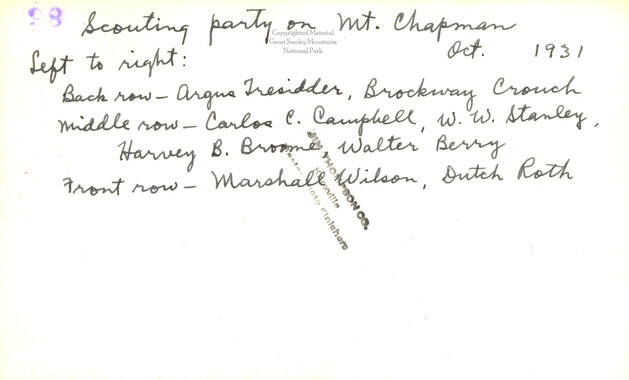
WCU - Great Smoky Mountains - A... Great Smoky Mountains... Great Smoky Mountains - A Park...
Scouting Party on Mount Chapman
-
Group at Montvale Springs Hotel

WCU - Great Smoky Mountains - A... Great Smoky Mountains... Great Smoky Mountains - A Park...
Group at Montvale Springs Hotel
1930-10-04
-
Senator Pritchard's questions regarding the park movement

WCU - Great Smoky Mountains - A... Great Smoky Mountains... Great Smoky Mountains - A Park...
Senator Pritchard's questions regarding the park...
1901-12-14
-
Great Smoky Mountains National Park, North Carolina- Tennessee
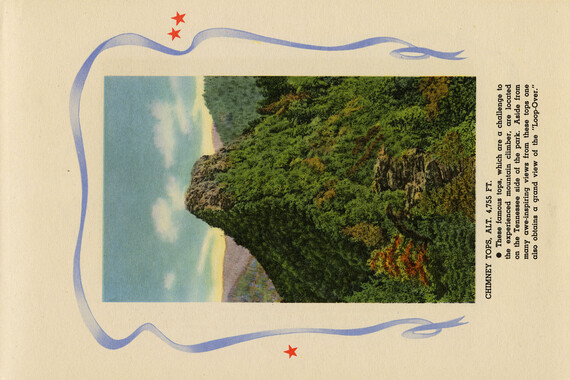
WCU - Great Smoky Mountains - A... Great Smoky Mountains... Great Smoky Mountains - A Park...
Great Smoky Mountains National Park, North...
-
Senate Bill 781
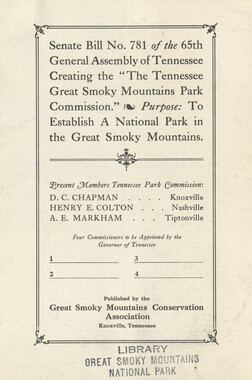
WCU - Great Smoky Mountains - A... Great Smoky Mountains... Great Smoky Mountains - A Park...
Senate Bill 781
1927-04-27
-
House of Representatives delegate list
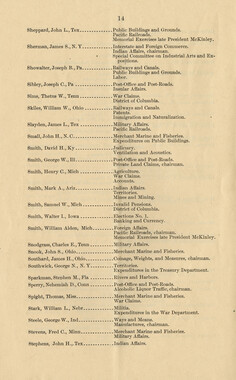
WCU - Great Smoky Mountains - A... Great Smoky Mountains... Great Smoky Mountains - A Park...
House of Representatives delegate list
-
Guyot's list of the peaks of the Great Smokies

WCU - Great Smoky Mountains - A... Great Smoky Mountains... Great Smoky Mountains - A Park...
Guyot's list of the peaks of the Great Smokies
1930;
-
Correspondence between Chase Ambler and Jeter Pritchard
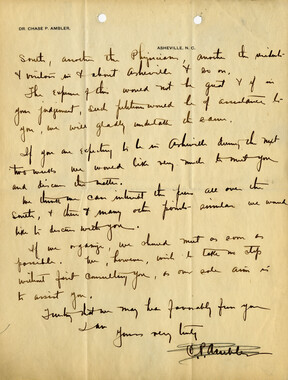
WCU - Great Smoky Mountains - A... Great Smoky Mountains... Great Smoky Mountains - A Park...
Correspondence between Chase Ambler and Jeter...
1899-08-19;
-
Nomenclature of Appalachian Mountains

WCU - Great Smoky Mountains - A... Great Smoky Mountains... Great Smoky Mountains - A Park...
Nomenclature of Appalachian Mountains
1931-01-28
-
Best Loved Scenes in the Smokies

WCU - Great Smoky Mountains - A... Great Smoky Mountains... Great Smoky Mountains - A Park...
Best Loved Scenes in the Smokies
-
Cades Cove

WCU - Great Smoky Mountains - A... Great Smoky Mountains... Great Smoky Mountains - A Park...
Cades Cove
-
Cataloochee tract 231: W. G. B. Messer

WCU - Great Smoky Mountains - A... Great Smoky Mountains... Great Smoky Mountains - A Park...
Cataloochee tract 231: W. G. B. Messer
1935-06-19;
-
Requests for information on Appalachian National Park

WCU - Great Smoky Mountains - A... Great Smoky Mountains... Great Smoky Mountains - A Park...
Requests for information on Appalachian National...
1900-01-24;
-
Study for the Preservation of Mountain Culture in Field Museum of History

WCU - Great Smoky Mountains - A... Great Smoky Mountains... Great Smoky Mountains - A Park...
Study for the Preservation of Mountain Culture in...
-
Correspondence regarding organizational meetings of the Appalachian National Park Association

WCU - Great Smoky Mountains - A... Great Smoky Mountains... Great Smoky Mountains - A Park...
Correspondence regarding organizational meetings...
1899-11-22
-
Subscriptions received by the Appalachian National Park Association
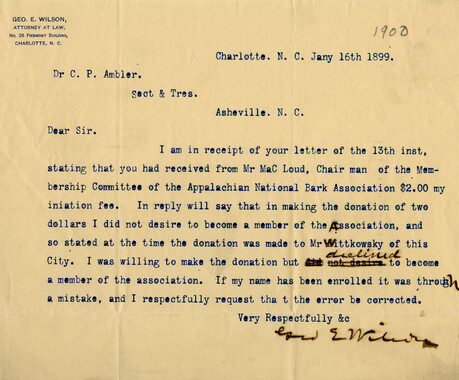
WCU - Great Smoky Mountains - A... Great Smoky Mountains... Great Smoky Mountains - A Park...
Subscriptions received by the Appalachian National...
1900-01-16;
-
Travel to Washington D.C.

WCU - Great Smoky Mountains - A... Great Smoky Mountains... Great Smoky Mountains - A Park...
Travel to Washington D.C.
1901-01-16;
-
Correspondence between Zebulon Weaver, R. C. D'Armand, and Mrs. Henry H. Horton
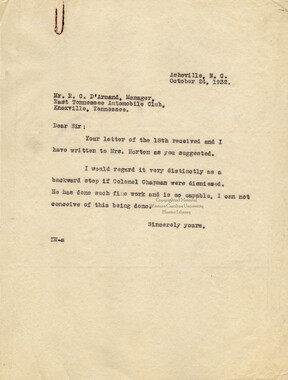
WCU - Great Smoky Mountains - A... Great Smoky Mountains... Great Smoky Mountains - A Park...
Correspondence between Zebulon Weaver, R. C....
-
Cataloochee tract 251: James H. Hannah

WCU - Great Smoky Mountains - A... Great Smoky Mountains... Great Smoky Mountains - A Park...
Cataloochee tract 251: James H. Hannah
circa 1948
-
Memorial presented to 56th Congress

WCU - Great Smoky Mountains - A... Great Smoky Mountains... Great Smoky Mountains - A Park...
Memorial presented to 56th Congress
-
Laurel Falls

WCU - Great Smoky Mountains - A... Great Smoky Mountains... Great Smoky Mountains - A Park...
Laurel Falls
-
White rhododendron in bloom
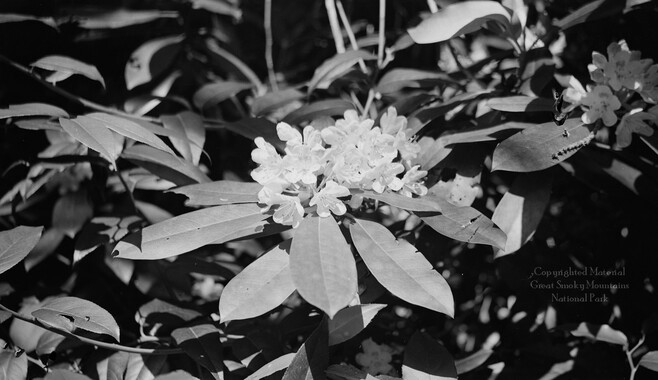
WCU - Great Smoky Mountains - A... Great Smoky Mountains... Great Smoky Mountains - A Park...
White rhododendron in bloom
1934-07-22
-
Mount Sterling fire tower
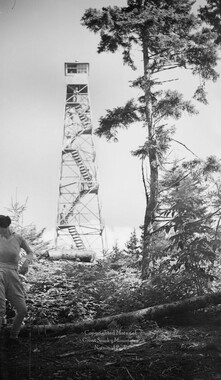
WCU - Great Smoky Mountains - A... Great Smoky Mountains... Great Smoky Mountains - A Park...
Mount Sterling fire tower
1934-09-02
-
Cataloochee tract 251: James H. Hannah

WCU - Great Smoky Mountains - A... Great Smoky Mountains... Great Smoky Mountains - A Park...
Cataloochee tract 251: James H. Hannah
1975-08
-
Complete Report Submitted to Governor Clyde R. Hoey

WCU - Great Smoky Mountains - A... Great Smoky Mountains... Great Smoky Mountains - A Park...
Complete Report Submitted to Governor Clyde R....
-
Cataloochee tract 213: Charles Ray Caldwell
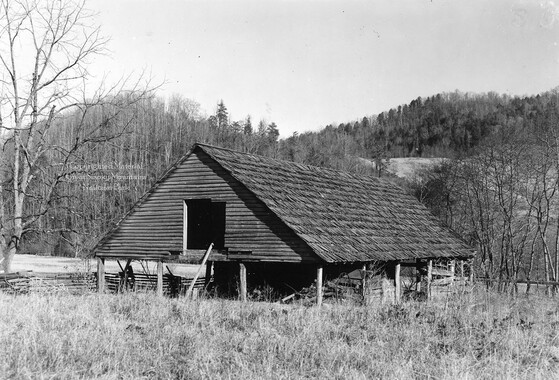
WCU - Great Smoky Mountains - A... Great Smoky Mountains... Great Smoky Mountains - A Park...
Cataloochee tract 213: Charles Ray Caldwell
1940-03-02;
-
Civilian Conservation Corps Annual: District "C"

WCU - Great Smoky Mountains - A... Great Smoky Mountains... Great Smoky Mountains - A Park...
Civilian Conservation Corps Annual: District "C"
-
Correspondence: C. P. Ambler to Jacob Ambler

WCU - Great Smoky Mountains - A... Great Smoky Mountains... Great Smoky Mountains - A Park...
Correspondence: C. P. Ambler to Jacob Ambler
1901-12-26
-
Handbook/ 1933/ Smoky Mountains Hiking Club
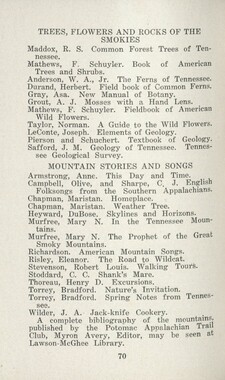
WCU - Great Smoky Mountains - A... Great Smoky Mountains... Great Smoky Mountains - A Park...
Handbook/ 1933/ Smoky Mountains Hiking Club
-
Financial receipts and expenditures, 1902

WCU - Great Smoky Mountains - A... Great Smoky Mountains... Great Smoky Mountains - A Park...
Financial receipts and expenditures, 1902



